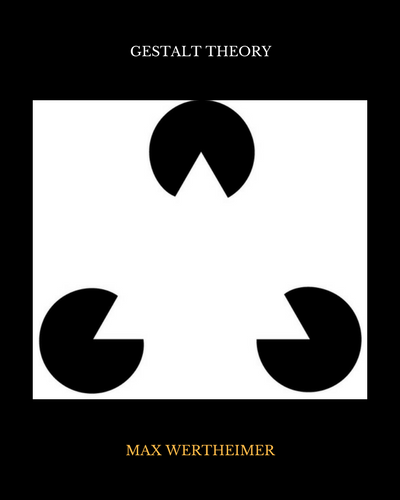Psychology Classics On Amazon

Gestalt Psychology
"Patterns" The New Psychology By Professor A. T. Poffenberger (1930)
Psychology is the science of running things. Driving an automobile, piloting an airplane building a house, writing a book constructing a machine, winning a war, making a success out of a business; all these are compounded out of human thoughts and actions. Thinking and doing; these are the materials of life or earth. To explain both is psychology's job.
Within one generation there have been three prominent sets of psychological theories. Not so long ago psychologists were explaining everything that human beings did or thought as due to a mysterious something called reason, as one explains the movements of a battleship by orders from the captain in the conning tower.
Some psychologists perceived, however, that people often did utterly unreasonable things, like committing murders in a fit of rage, or investing in stocks known to be valueless. Such dearly unreasonable acts and thoughts were blamed on emotions or impulses. On one form of this idea has been built the theory of psychology associated with the name of Freud.
Next came the behaviorist psychology, chiefly urged by Dr. John B. Watson, formerly of Johns Hopkins University. To the extreme behaviorist a human being is little more than a bundle of actions and reactions, to be studied much as a mechanic studies the workings of an automobile engine, or as a biologist studies the behavior of a white rat in a cage. As a critic has said, "Behaviorists forget that a man is sometimes conscious."
Finally, within the last few years has come still a newer set of theories, the so-called "Gestalt" psychology, or psychology of patterns, for "gestalt" means pattern in German. Small wonder among these conflicting theories, that many people and even some psychologists get confused and imagine the whole science in a state of continual explosion.
That is not true. The supposed "revolutions" in recent psychology have been like chips tossing about on the surface of a river, while the steady stream of careful scientific investigation has flowed on unceasingly beneath.
The newest Gestalt psychology, for example, has grown from facts gradually discovered in the course of years by the study of senses like sight and hearing and may be most easily illustrated by some facts about optical illusions.
If the printer of this magazine, for example, accidentally left out one letter of a word in this sentence, many readers would not perceive the misprint. They would supply the missing letter mentally; for most adults and many young children read whole words as single eye-patterns not each letter individually. In music, melody is recognized as the same regardless of the particular key in which it happens to be played. The average ear perceives no difference because it is the pattern of the tones that is heard and not the separate tones individually.
Even the cartoons in the Sunday newspaper are examples of how almost everybody uses unconsciously this perception of patterns or "gestalts." Faces and bodies of the cartoon characters are grossly distorted by the artists. An actual man who looked exactly like Andy Gump or little Jeff would be worse than a side-show freak. Even whole parts of faces or bodies can be left out of the cartoons without making these familiar characters unrecognizable. The eyes or the minds of habitual readers immediately supply the lack. Everything is ordinarily perceived all of a piece.
The Gestalt psychology, chiefly urged by the distinguished German students of psychology, Dr. Kurt Koffka and Dr. Wolfgang Kohler, takes as its central conclusion the idea that this automatic completing of patterns and recognition by patterns is a universal habit of the mind, not merely of the senses. The whole of any habitual sight, sound, or idea is perceived, this theory says, when a sufficient part of it is supplied. If this new viewpoint proves to be generally valid for complicated ideas and mental states, as well as for simple things like cartoons and musical melodies, its practical importance will depend upon its suggestions about how people learn new ideas or acquire new habits.
This learning, the Gestalt psychologist says, is not by the laborious, unit by unit method in which the average child learns the letters of the alphabet. Instead, more or less complicated patterns are learned each as a complete whole, just as many children nowadays learn to read by whole words instead of by letters. The whole picture of CAT, for example, means the animal; not the combination of separate pictures of C and A and T.
This means, of course, that what one has learned must control one's entire set of perceptions, thoughts, mental characteristics, and actions. Only people who have learned the English-language meaning of the pattern CAT will assign that meaning to it. To others it will be meaningless or will mean something else.
An extreme interpretation of Gestalt psychology would seem to say that everything depends upon what set of patterns of life or thinking one happens to have learned; for the idea is presumably as applicable to morals, religion, and social customs as to the perception of patterns learned by ear or eye. To explain impulsive, unreasonable acts such as violent crimes or foolish promises the Gestalt psychologist would not blame overpowering emotions or poor reasoning powers, but would merely assume that the victim of such temporary unreason happens to have learned a wrong pattern of thought or action, which pattern some subsequent event called up and set to going.
This conception of human nature may easily result, as many of its predecessors have done in suggesting experiments and aiding the steady advance of psychology. Gestalt psychology may seem at first to be merely an elaboration of the behaviorist theory. Actually it is a contradiction. Behaviorism asserts that certain definite stimuli cause certain definite reactions — that a lunge of a fist toward a subject's face cause him to wince, for example. Gestalt says the the reaction depends on the circumstances under which the stimulus is applied and the conditions of the organism to which it is applied - the whole pattern, in other words, rather than one stimulus. Thus the lunge of a friend's fist causes a different reaction than that of a stranger.
The psychology of Professor Sigmund Freud, of Vienna, first of the new psychological viewpoints of recent years, may be described as a simplified and intensified version of the much older idea of impulses. Professor William James and other psychological leaders of the last century thought of man as moved by many impulses, like a clockwork mechanism with many different springs. A favorite phrase of that time, indeed, was "springs of human action." Such impulses or "motives" were listed in large number: selfishness, honesty, ambition, indolence, generosity, patriotism, and so on. Psychologists busily searched out hundreds of these different motives.
One of the great services of Dr. Freud is that he perceived the impossible complexity of this search, and strove to reduce those many mysterious springs of human action to a smaller number. In the end, he concluded that only one fundamental spring was necessary to make the mind go round. That single mainspring he found in the impulses of sex.
This particular selection, however, is no real necessity of Freudian psychology. A shipwrecked sailor on a desert island would probably find the mainspring of his actions in the desire for food. There are people whose whole lives seem guided by single motives of religion, patriotism, scientific research, or something else impersonal. Freudian theorists by no means ignore these examples of apparently sexless motives, but ascribe them to the forces of sex emotions which have been "sublimated" or turned into other, less personal, channels.
One of Dr. Freud's former pupils, Dr. Alfred Adler, who now represents a conflicting psychoanalytic school, selects as his choice for the single motive or "mainspring" the desire for self-expression. Every human being, he holds, is born with some mental urge which has to be expressed in the course of life in order to bring normality and happiness. Other psychoanalytic schools have selected still other single mainsprings for the human motive power.
The one essential back of them all is the one motive idea. Whether that one impulse is being released, thwarted, suppressed, sublimated or otherwise disposed of explains all of the frequently unreasonable actions of mankind, the psychoanalysts urge, as well as the so- called reasonable ones. They contend that if the one ruling motive is denied reasonable expression that may result in many kinds of mental or bodily 'disturbance; effects of "suppressed desires."
Psychoanalysis is merely a procedure by which the skilled psychologist may delve into the hidden part of his patient's mind, often called the "subconscious" or "unconscious" mind, and discover what has happened to this single human motive of sex or something else in that person's thoughts or actions; what "complexes," "inhibitions" or past experiences are suppressing or perverting some explosive motive which ought to be more safely released.
The Freudian ideas did not make their way in the scientific world without much opposition and argument. Hope of settling some of these arguments by actual experiment was one of the inspirations for the newer behaviorist psychology of Dr. Watson, a viewpoint which Is still scarcely twenty years old. What people say about themselves, everybody admits, it often far from the truth. Why not try to discover the mainsprings of human nature, Dr. Watson asked, by examining what people do?
Behaviorism began in the study of the psychological reactions of animals to various controlled conditions. Similar tests can be used, Dr. Watson perceived, to test human beings. With very young babies, for example, it was discovered that fire, live animals, and similar things ordinarily regarded as dangerous and frightful do not cause fear. Only two truly human fears were discovered in these infants, fear of falling and fear of a loud sharp noise. Behavioristic methods are still practically the only ones available, for the study of young infants.
As a philosophy, behaviorism implies that all human thought and action results from more or less mechanical and automatic reactions to external stimuli; like an automatic vending machine which always gives up the chewing gum when one inserts a penny. For the imagined captain in the conning tower, behaviorism substitutes a competent but will-less automaton. Whatever touches the proper stimulus gets the corresponding result.
To the argument between the Freudian, one motive idea of a single mainspring controlling human actions and the older idea of many such controlling motives, the experiments of the behaviorists and others seem to have provided an answer. Neither opinion is right. It is now safe to say that human beings are not ruled by any one motive or impulse, such as sex or self-expression. On the other hand, the human mind certainly does not possess the vast series of complicated motives about which earlier psychologists talked.
The truth seems to be that people are swayed by more than one fundamental motive but only by relatively few, including self preservation, desire for comfort, hunger, sex, and also such things as Dr. Adler's supposed mainspring of self-expression. Present knowledge is not sufficient to permit stating even a partial list of these psychological fundamentals, but it is possible to say that they are not so numerous as was at one time supposed.
Gestalt Psychology Classic
Translated and published in Willis Ellis' Sourcebook of Gestalt Psychology, this classic text in the history of Gestalt Psychology was originally presented by Max Wertheimer as an address before the Kant Society in Berlin, on the 17th of December, 1924. To read in full, click the image above or visit the following link.
This stylish Gestalt T-Shirt is is available from Amazon (prime eligible) in a range of colors for women and men. Perfect for anybody with an interest in this fascinating perceptual branch of psychology most closely associated with the pioneering work of Max Wertheimer, Wolfgang Köhler, and Kurt Koffka.
Inspired by the Gestaltist principle that the whole is more than the sum of its parts, this will also appeal to students, teachers, psychologists and therapists familiar with the science of illusions and the Law of Closure. Sales help support All-About-Psychology.Com which has been providing free and comprehensive information and resources for psychology students and educators since 2008.
Recent Articles
-
All About Psychology
Apr 22, 25 02:37 PM
A psychology website designed to help anybody looking for detailed information and resources. -
Sponsor a Psychology Website with Over a Million Yearly Visitors
Apr 22, 25 10:07 AM
Showcase your brand to a huge, engaged audience. Discover how to sponsor a psychology website trusted by over a million visitors a year. -
Billy Milligan Case Study: Psychology, Crime, and the Split Mind
Apr 18, 25 09:10 AM
Was Billy Milligan a fractured victim—or a manipulative genius? This Billy Milligan case study explores the psychology behind one of history’s most controversial trials.
Please help support this website by visiting the All About Psychology Amazon Store to check out an awesome collection of psychology books, gifts and T-shirts.
Go From Gestalt Psychology Back To The Home Page







New! Comments
Have your say about what you just read! Leave me a comment in the box below.